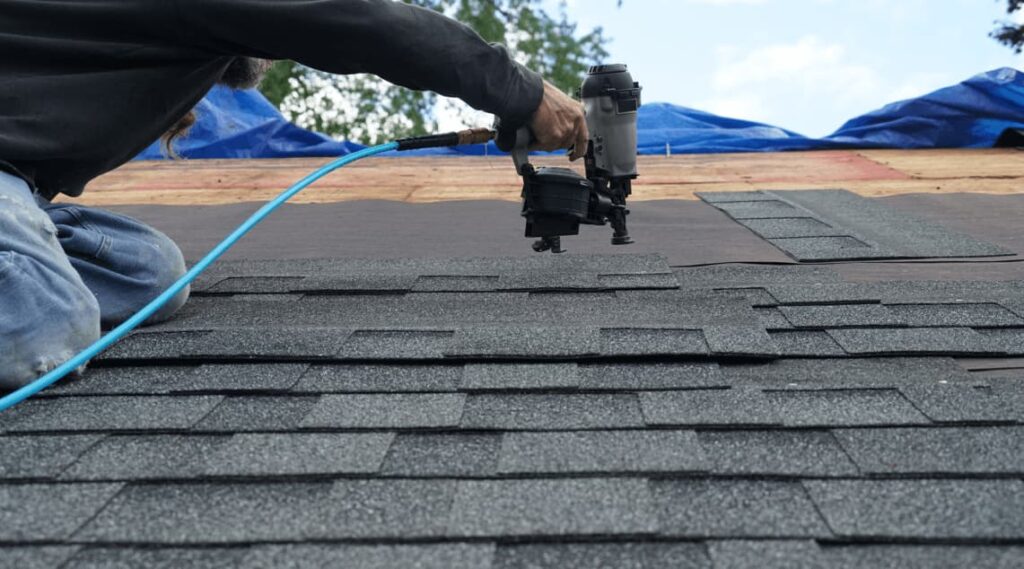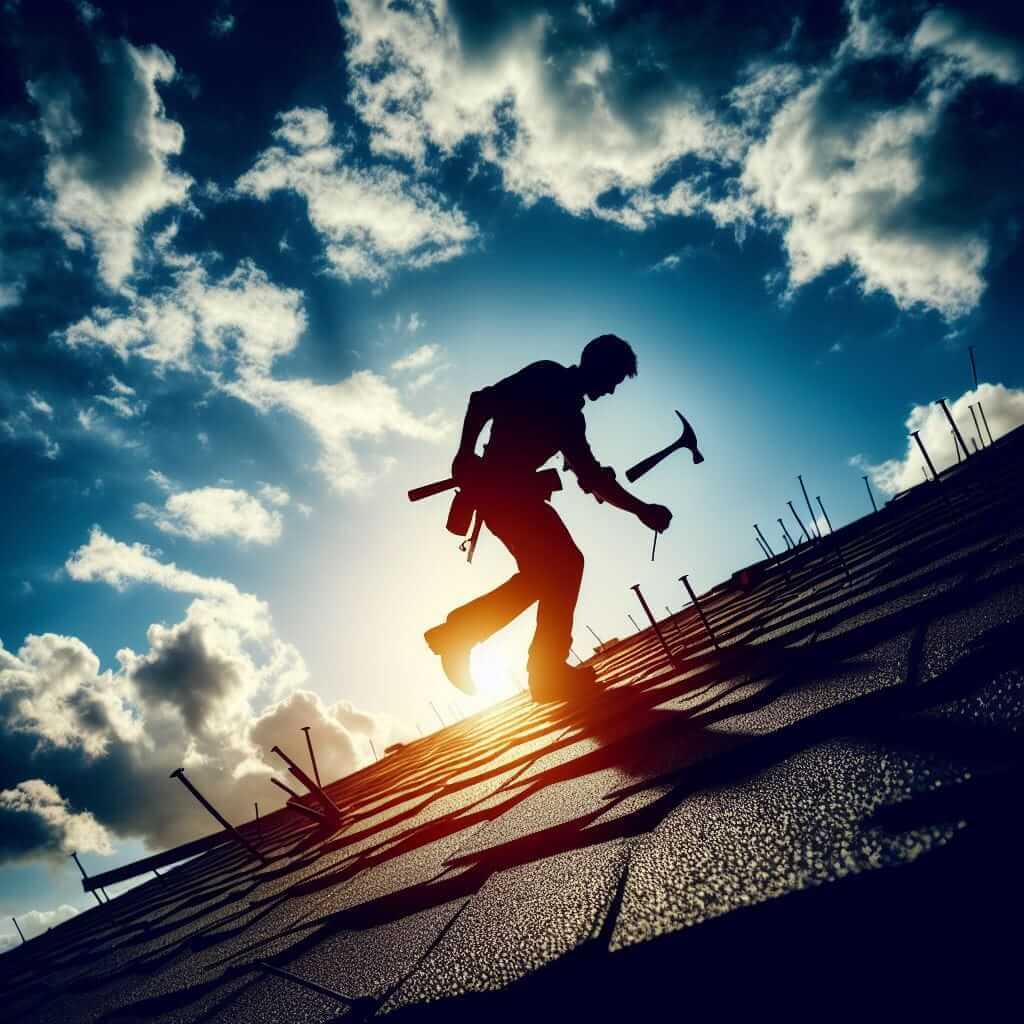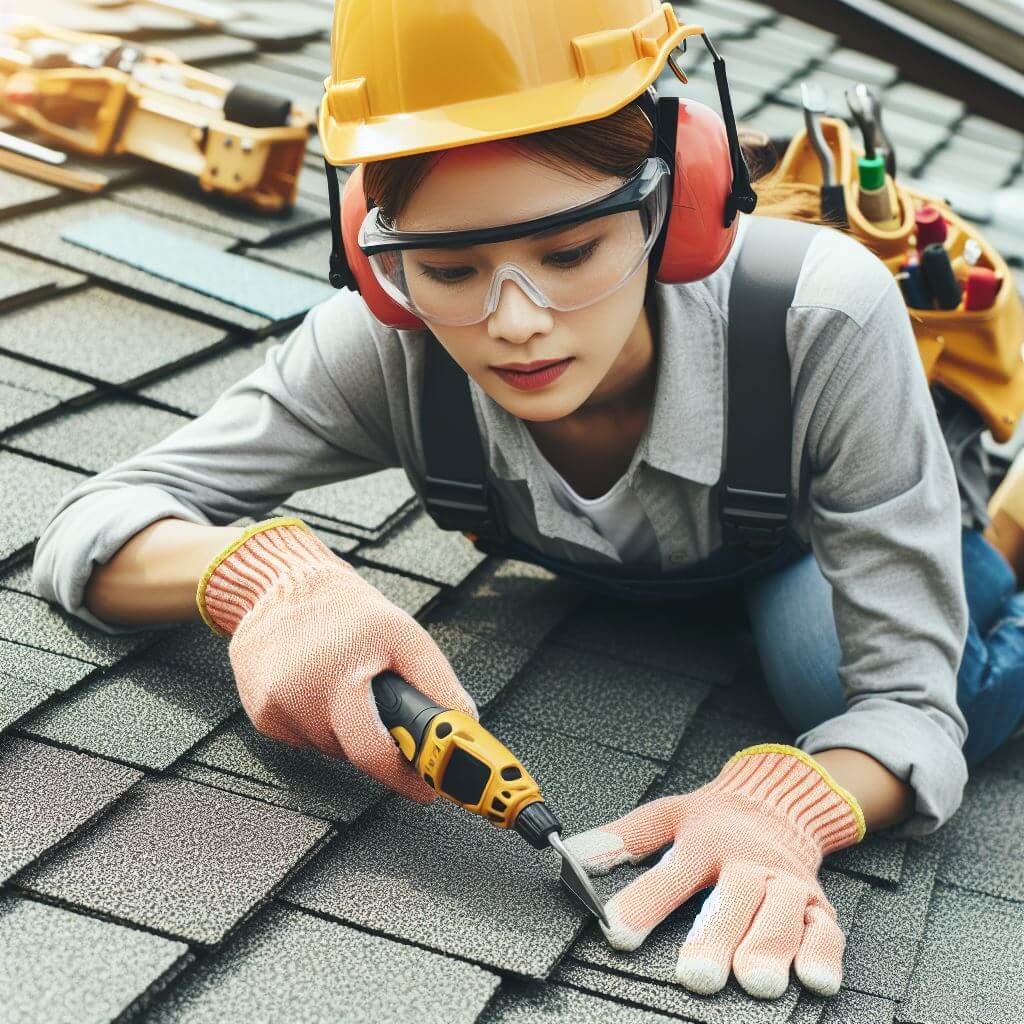Repair
Shingle Roof Repair: A Comprehensive Guide for Homeowners
Shingle Roof Repair? A well-maintained roof is crucial for the longevity and integrity of your home. Shingle roofs, in particular, require regular attention to ensure they can withstand the elements and protect your property effectively.
In this comprehensive guide, we’ll walk you through the essential aspects of shingle roof repair, from identifying signs of damage to preventive maintenance and professional assistance.
1. Signs of damaged shingles:
1.1. Curling:
Curling shingles are a clear indicator of wear and tear. Over time, shingles can curl upwards or downwards, exposing vulnerable areas to the elements. This compromises their ability to provide effective protection against water infiltration.
1.2. Cracking:
Cracked shingles are a common consequence of prolonged exposure to sunlight and adverse weather conditions.
These fissures compromise the shingles’ structural integrity, making them less effective in shielding your home from potential leaks.
1.3. Granule Loss:
The granules on shingles act as a protective layer against UV rays and harsh weather. If you notice a significant loss of granules, it’s a sign that your shingles are aging and becoming less effective.
This compromises their ability to shield your roof from the elements.
Explore shingles with enhanced granule adhesion for long-lasting protection. Unlock the secrets of successful repairs. Click to get started!
1.4. Missing Shingles:
Perhaps the most obvious sign of damage, missing shingles expose your roof’s underlayment directly to the elements.
Promptly replacing missing shingles is crucial to prevent water damage and maintain the structural integrity of the roof.
1.5. Why prompt attention is crucial:
Timely addressing of these signs is crucial to preventing further damage to your roof and the interior of your home. Ignoring these indicators can lead to more extensive and expensive repairs down the line.
By understanding and promptly addressing damaged shingles, homeowners can extend the life of their roofs and avoid costly repairs.
2. Preparatory Steps for Roof Shingle Repair:
2.1. Assessing the Damage:
Before initiating the repair process, conduct a thorough assessment of the shingle damage. Walk around your roof and identify areas with curling, cracking, granule loss, or missing shingles.
This phase is crucial for figuring out how much damage has been done and planning the necessary repairs.
2.2. Gathering Tools and Materials:
Once you’ve assessed the damage, gather the tools and materials needed for the repair. Essential tools include a hammer, roofing nails, a pry bar, a utility knife, and a caulking gun.
Materials may include replacement shingles, roofing cement, and flashing.
2.3. Choosing the Right Replacement Shingles:
Selecting replacement shingles is a critical step in ensuring a successful repair. Consider factors such as the type, color, and texture to seamlessly integrate new shingles with the existing ones.
Opt for shingles that match your roof’s specifications for a cohesive and visually appealing result.
Browse a variety of replacement shingles that suit your roof’s needs and enhance its overall aesthetics. Take the first step towards better repairs. Click to learn how.
3. Safety Precautions During the Repair Process:
Safety is paramount during any roof repair project. Implementing proper precautions ensures the well-being of the individuals involved and contributes to the overall success of the repair.
3.1. Understanding the Importance of Safety:
Roof repairs involve working at heights, presenting inherent risks. Prioritizing safety is crucial to prevent accidents, injuries, and property damage. Recognize the importance of safety measures for a secure repair process.
3.2. Essential Safety Gear:
- Equip yourself with the necessary safety gear to minimize risks. Key items include:
3.2.1. Sturdy Footwear:
-
- Wear slip-resistant, sturdy footwear to maintain a stable grip on the roof surface.
3.2.2. Safety Harness:
-
- Utilize a safety harness to prevent falls and provide additional protection.
3.2.3. Gloves:
-
- Wear durable gloves to protect your hands during the handling of tools and materials.
3.2.4. Eye Protection:
-
- Use safety glasses to shield your eyes from debris and potential hazards.
3.3. Choosing Optimal Working Conditions:
3.3.1. Dry Weather:
-
- Plan repairs during dry weather to minimize the risk of slipping on wet surfaces.
3.3.2. Daylight Hours:
-
- Perform repairs during daylight hours to ensure visibility and reduce accidents.
3.4. Ladder Safety:
3.4.1. Stable Placement:
-
- Ensure the ladder is stable and securely placed on a level surface before climbing.
3.4.2. Proper Angle:
-
- Set the ladder at a proper angle, following manufacturer guidelines, to prevent tipping.
3.5. Buddy System:
3.5.1. Working with a Partner:
- Whenever possible, collaborate with a partner for assistance and added safety.
4. The Repair process:
4.1. Secure the work area:
Before beginning the repair, secure the work area. Clear the debris and any obstacles from the roof. Ensure the ladder is stable and securely positioned.
This step sets the foundation for a safe and efficient repair process.
4.2. Remove damaged shingles:
Using a pry bar or a similar tool, carefully lift and remove damaged shingles. Start with the damaged shingle’s upper edge and work your way down. Take extra care to avoid damaging adjacent shingles during removal.
4.3. Inspect the Underlayment:
Once the damaged shingles are removed, inspect the underlayment for any indication of water damage or deterioration.
Address any issues you find before installing new shingles to ensure a solid foundation for your roof.
4.4. Install Replacement Shingles:
Place the new shingles in the same pattern as the existing ones. Nail them securely into place using roofing nails.
Ensure the replacement shingles fit snugly and align with the surrounding shingles for a seamless appearance.
4.5. Using Roofing Cement:
Using Roofing Cement around the boundaries of the new to create a watertight seal.
This step is crucial for preventing water infiltration and ensuring the longevity of the repair. Use a caulking gun for precise application.
4.6. Inspect the Entire Roof:
After completing the repair, conduct a thorough inspection of the entire roof. Look for any additional damage or potential issues that may require attention. Addressing issues promptly can prevent future problems.
5. Preventive Maintenance for Shingle Roofs:
5.1. Routine Roof Inspections:
Schedule routine roof inspections to identify potential issues before they escalate. Check for signs of damage, such as curling, cracking, or missing shingles.
Early detection allows for timely repairs and preserves the overall integrity of the roof.
5.2. Cleaning Debris:
clear the debris such as leaves, branches, and moss regularly. Debris buildup can retain moisture. leading to mold growth and accelerated shingle deterioration.
Regular cleaning ensures a clean and well-maintained roof.
5.3. Gutter Maintenance:
Keep gutters clear of debris to ensure proper drainage. Clogged gutters can lead to water pooling on the roof, causing damage to shingles and the underlying structure.
Regularly clean gutters and check for any indication of damage.
5.4. Addressing Algae and Moss:
Algae and moss can thrive on shingle roofs, causing aesthetic issues and potential damage. Use an appropriate cleaning solution to remove algae and moss, preserving the appearance and functionality of your shingles.
5.5. Trim Overhanging Branches:
Overhanging branches can scrape against the roof and deposit debris. Trim branches regularly to prevent damage to shingles and reduce the risk of fallen branches during storms.
5.6. Prompt Issue Addressing:
If you identify any issues during inspections, address them promptly. Whether it’s a loose shingle, damaged flashing, or a small leak, timely repairs prevent further damage and extend the lifespan of your shingle roof.
6. Professional Assistance:
Seeking professional assistance for roof shingle repair is advisable in certain situations. While many repairs can be handled by homeowners, there are scenarios where the expertise of a roofing professional is crucial.
Understanding when to call for professional help ensures the safety of your home and the longevity of the roof.
6.1. Extent of Damage:
If there is significant damage to your shingle roof, involving a large area or affecting multiple shingles, it’s advisable to consult a roofing professional.
They have the experience to assess the overall condition of the roof and recommend comprehensive solutions.
6.2. Unclear Issues:
Sometimes, identifying the root cause of shingle damage can be challenging for homeowners.
If you’re uncertain about the underlying issues causing the damage, seeking the expertise of a roofing professional ensures a precise diagnosis and targeted repairs.
6.3. Beyond Homeowner’s Comfort Level:
Roof repairs often involve working at heights and require a level of expertise. If the repair task is beyond your comfort level or poses safety concerns, Hiring a professional is recommended.
They are equipped with the necessary skills and safety measures to handle complex repairs.
7. How to Choose a Reliable Roofer:
When opting for professional assistance, it’s crucial to choose a reliable and experienced roofer. Consider the following factors to ensure you hire a professional who can effectively address your shingle roof repair needs.
7.1. Credentials and Licensing:
Check for the roofer’s credentials and licensing. A reputable professional should be properly licensed and adhere to industry standards.
This ensures that they possess the required training and qualifications to perform quality repairs.
7.2. Insurance Coverage:
Ensure the roofing professional has adequate insurance coverage. This protects you from liability in case of accidents or damages that may occur during the repair process.
Request proof of insurance before hiring a roofer.
7.3. References and Reviews:
Read customer reviews and ask for references from past clients. A reputable roofer should have a positive track record of delivering quality work.
Checking reviews and references helps you assess their reliability and customer satisfaction.
8. Roof Repair Costs and Options:
Understanding the costs associated with roof repairs is crucial for homeowners. The expenses can vary based on factors such as the type of repair needed, the roofing material, and the size of the roof.
Additionally, exploring different repair options, including restoration solutions, provides a comprehensive view of available choices.
8.1. Estimating Roof Repair Costs:
Determining the cost of roof repairs involves considering various factors. The type of roofing material, the extent of the damage, and the size of the roof all contribute to the overall expense.
Obtain estimates from reputable roofing professionals to get a clear picture of the potential costs.
8.2. Roof Replacement vs Restoration:
Assess whether your roof requires a complete replacement or if restoration is a viable option. Roof restoration solutions, such as Roof Maxx, can be a cost-effective alternative to prolonging the life of your shingles.
Consider the long-term benefits and costs associated with each option.
Explore Roof Maxx as an affordable solution for roof restoration. Don’t wait! Dive into the world of effective repairs. Click to begin.
9. DIY vs. Hiring a Professional:
Choosing between do-it-yourself (DIY) repairs and hiring a professional depends on various factors.
Assess the complexity of the repair task, your comfort level with DIY projects, and the potential cost savings before deciding on the most suitable approach.
9.1. Pros and Cons of DIY Roof Repairs:
DIY roof repairs can be cost-effective, but they come with challenges. Assess the pros and cons, considering factors such as your skill level, the availability of tools, and the potential risks.
Simple repairs, such as fixing a small leak, may be suitable for DIY, while more complex tasks might require professional assistance.
9.2. Hiring a Professional Roofer:
Hiring a professional roofer ensures that the repair task is completed with expertise and in compliance with industry standards.
Professionals possess the required tools and experience to address complex issues. Consider your budget, the scope of the repair, and the urgency when deciding to hire a roofing professional.
10. Roof Repair References and External Sources:
Expand your knowledge of roof repair costs and related topics by exploring external sources and references.
Consult reputable news articles, websites, and blogs to gain insights into industry trends, cost considerations, and emerging technologies in roof repair.
10.1. External Sources for Roof Repair Information:
Delve into external sources to stay informed about the latest developments in roof repair.
Reputable websites, news articles, and blogs can provide valuable information on cost-effective solutions, industry best practices, and emerging technologies.
Explore external sources for in-depth information on roof repair and cost considerations. Empower your repairs now. Take action and learn more!
11. DIY vs. Hiring a Professional:
Deciding between taking a do-it-yourself (DIY) approach and hiring a professional for roof repairs is a crucial decision for homeowners.
Factors such as the complexity of the repair, personal skill level, and available resources play a significant role in making an informed choice.
11.1. Pros and Cons of DIY Roof Repairs:
Taking on a DIY roof repair project can be a cost-effective option, but it comes with its own set of considerations.
Understanding the pros and cons is essential for homeowners looking to tackle repairs independently.
11.1.1. Pros of DIY Roof Repairs:
-
- Cost Savings: DIY repairs often involve lower costs as you are not paying for professional labor.
- Personal Satisfaction: Completing a repair on your own can bring a sense of accomplishment.
- Flexibility: You have control over the timing and pace of the repair project.
11.1.2. Cons of DIY Roof Repairs:
-
- Safety Concerns: Roof repairs can be hazardous; lack of experience may result in accidents.
- Limited Expertise: DIYers may lack the specialized knowledge needed for certain repairs.
- Time-Consuming: DIY projects can take longer, especially if you’re learning as you go.
11.2. Hiring a Professional Roofer:
Opting for professional assistance ensures that the repair is carried out with expertise and adherence to safety standards.
While it involves an investment, the benefits may outweigh the drawbacks for complex or critical repairs.
11.2.1. Pros of Hiring a Professional Roofer:
-
- Expertise: Professionals bring specialized knowledge and experience to handle various roof repairs.
- Efficiency: Professionals are equipped with the necessary tools and can complete repairs more quickly.
- Safety: Trained roofers prioritize safety, reducing the risk of accidents during repairs.
11.2.2. Cons of Hiring a Professional Roofer:
-
- Cost: Professional services may involve higher costs due to labor and expertise.
- Scheduling: Dependence on the roofer’s schedule may lead to longer wait times for repairs.
- Less Control: Homeowners have less control over the repair process compared to DIY projects.
12. How to Locate and Replace Damaged Roof Shingles:
Repairing damaged roof shingles is a common maintenance task that homeowners may encounter.
Understanding the process of identifying, removing, and replacing damaged shingles is crucial for effective roof maintenance.
12.1. The Importance of Identifying and Replacing Damaged Shingles:
Recognizing signs of damage, such as curling, cracking, or missing shingles, is the first step to maintaining a watertight roof.
Promptly replacing damaged shingles ensures the longevity and structural integrity of the roof.
12.2. Safety Precautions and Tools Needed:
Before starting any roof repair project, prioritize safety. Equip yourself with the necessary protective gear, including sturdy footwear, gloves, and safety glasses.
Additionally, gather tools such as a pry bar, roofing nails, a utility knife, and replacement shingles.
12.3. How to Fix Cracked or Split Shingles:
In some cases, shingles may develop cracks or splits. Learn how to repair these issues without removing the entire shingle.
Utilize adhesive to seal cracks effectively, preserving the functionality of the shingle and preventing further damage.
12.4. Guide on Locating and Replacing Shingles:
12.4.1. Identify Damaged Shingles:
-
- Walk the perimeter of the roof and visually inspect for signs of damage.
- Look for curling, cracking, or missing shingles, and note their locations.
12.4.2. Secure the Work Area:
-
- Clear the roof of any debris to create a safe work environment.
- Ensure your ladder is stable and securely positioned before climbing.
12.4.3. Remove Damaged Shingles:
-
- Use a pry bar to carefully lift and remove damaged shingles.
- Start at the upper edge of the damaged shingle and work your way down.
12.4.4. Inspect the Underlayment:
-
- Examine the underlayment for any signs of water damage or deterioration.
- Address any issues found before installing new shingles.
12.4.5. Install Replacement Shingles:
-
- Place the new shingles in the same pattern as the existing ones.
- Nail them securely into place, ensuring a snug fit and alignment with surrounding shingles.
12.4.6. Using roofing cement
-
- Using roofing cement around the boundaries of the new shingles to create a watertight seal.
- Use a caulking gun for precise application.
12.5. References and Expert Interview:
Consult external references and consider insights from expert interviews to enhance your knowledge of effective shingle repair techniques.
12.5.1. External References:
-
- Explore reputable websites, articles, and blogs for detailed guides on roof shingle repair.
- Stay informed about the latest tools and materials available for effective repairs.
12.5.2. Expert Interview:
-
- Seek advice from experienced roofing contractors or maintenance professionals.
- Inquire about best practices, emerging technologies, and recommended tools for shingle roof repair.
Connect with certified roofing professionals for expert advice on shingle roof maintenance. Ready to fix it? Click here to explore the repair process.
13. References and Expert Insights:
Gaining a deeper understanding of roof repair and related topics involves consulting external sources and tapping into the expertise of professionals in the field.
References to credible sources and insights from experts provide valuable knowledge for homeowners seeking comprehensive information on shingle roof repair.
13.1. External Sources for Roof Repair Information:
Exploring external sources such as reputable websites, news articles, and blogs can offer insights into industry trends, cost considerations, and emerging technologies in roof repair.
13.1.1. Reputable Websites:
-
- Identify trustworthy websites that specialize in roofing and home maintenance for reliable information.
- Look for articles and guides from reputable sources to stay informed about the latest developments.
Explore external sources for in-depth information on roof repair and cost considerations. “Discover the difference! Start your repair journey today.”
13.1.2. News Articles and Blogs:
-
- Stay updated on industry news through relevant articles and blogs.
- Follow blogs written by experienced professionals or companies specializing in roofing for expert insights.
13.2. Expert Interviews:
Interviewing professionals in the roofing industry can provide valuable insights and tips for homeowners. Seek guidance from roofing contractors and maintenance professionals to supplement your knowledge.
13.2.1. Selecting Reliable Experts:
-
- Identify certified and experienced roofing contractors with a proven track record.
- Look for maintenance professionals who specialize in shingle roofs for targeted insights.
13.2.2. Key Questions for Expert Interviews:
-
- Ask about common issues with shingle roofs and effective maintenance strategies.
- Inquire about the latest technologies and materials recommended for shingle roof repair.
Conclusion:
In conclusion, proactive maintenance and timely repairs are essential for a durable and reliable shingle roof.
Whether you’re a DIY enthusiast or prefer professional assistance, this guide equips you with the knowledge needed to keep your roof in top condition.
Remember, a well-maintained shingle roof ensures the protection and comfort of your home for years to come.
Frequently Asked Questions
1. Can shingles on a roof be repaired?
A. Yes, shingles on a roof can be repaired. Repairs may involve fixing individual damaged shingles or addressing specific issues like leaks.
2. Can you replace just a few shingles?
A. Yes, it’s possible to replace just a few shingles instead of the entire roof. This is common for localized damage or wear.
3. How do you repair a section of shingles?
A. To repair a section of shingles, you typically remove the damaged shingles, replace them with new ones, and ensure proper sealing. It’s important to follow proper roofing procedures to maintain the integrity of the roof.
4. How do you fix a leaking shingle roof?
A. Fixing a leaking shingle roof involves identifying the source of the leak, removing damaged shingles, replacing them, and addressing any underlying issues. Proper sealing and waterproofing are crucial steps in preventing further leaks.
5. Repairing wind-damaged shingles:
A. After a windstorm, inspect the roof for loose or damaged shingles. Secure loose shingles with roofing cement or replace them as needed. Check for any structural damage and address it accordingly.
6. Shingle roof patch kit?
A. Shingle roof patch kits are available for DIY repairs. They typically include materials like roofing cement and patches to seal small holes or cracks in shingles.
7. Roof shingle repair near me?
A. Look for local roofing professionals or contractors who specialize in shingle roof repairs. Online directories, recommendations, or contacting local roofing companies can help you find services near you.
8. How to patch a small hole in a shingle roof?
A. Clean the area around the hole, apply roofing cement, and press a patch into place. Ensure a tight seal and smooth the edges. This helps prevent water infiltration.
9. Can you replace individual shingles?
A. Yes, individual shingles can be replaced. Carefully remove the damaged shingle, lift surrounding shingles, install the new shingle, and secure it in place with roofing nails. Proper sealing is essential.
Note: Remember, if you’re not comfortable or experienced with roofing repairs, it’s advisable to consult a professional for safe and effective solutions.
Recent Posts
- How to Repair RV Roof: The Ultimate Guide
- Metal Roof Repair: Ultimate Guide to Resilient Solutions
- Clay Tile Roofing: Timeless Beauty, Enduring Strength
- Flat Roof Repair: A Step-By-Step Approach
- What is EPDM Roofing: A Comprehensive Guide








